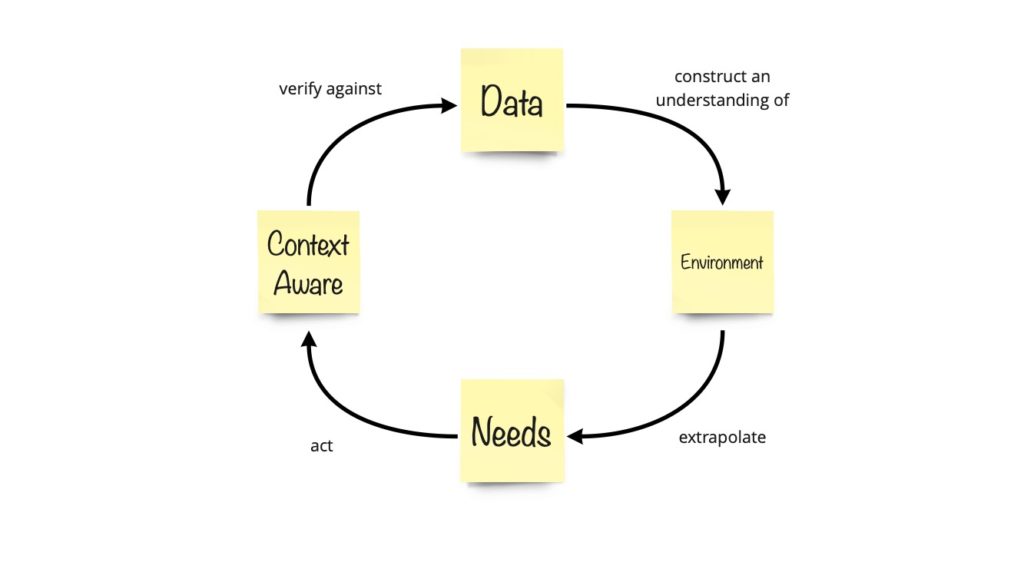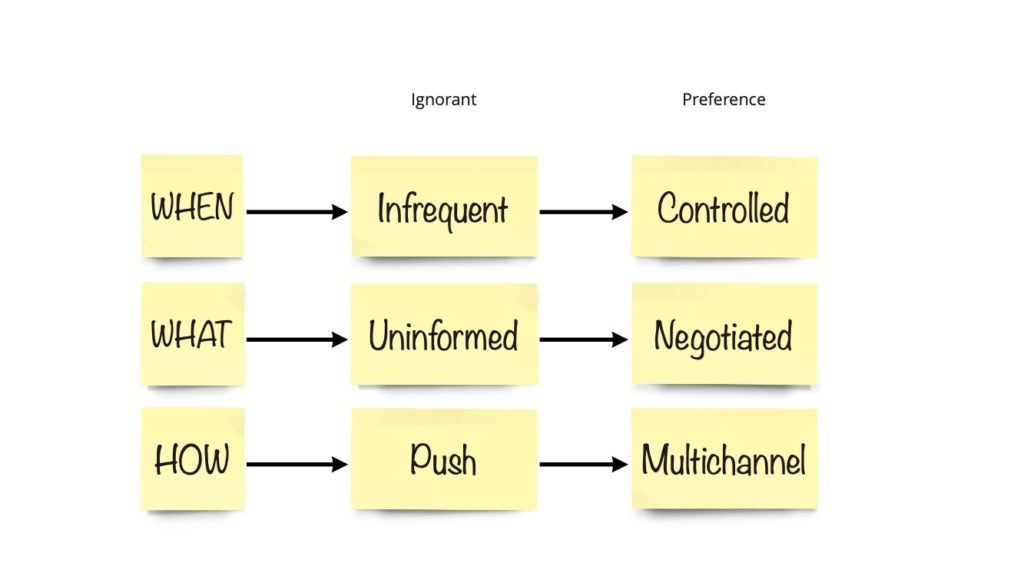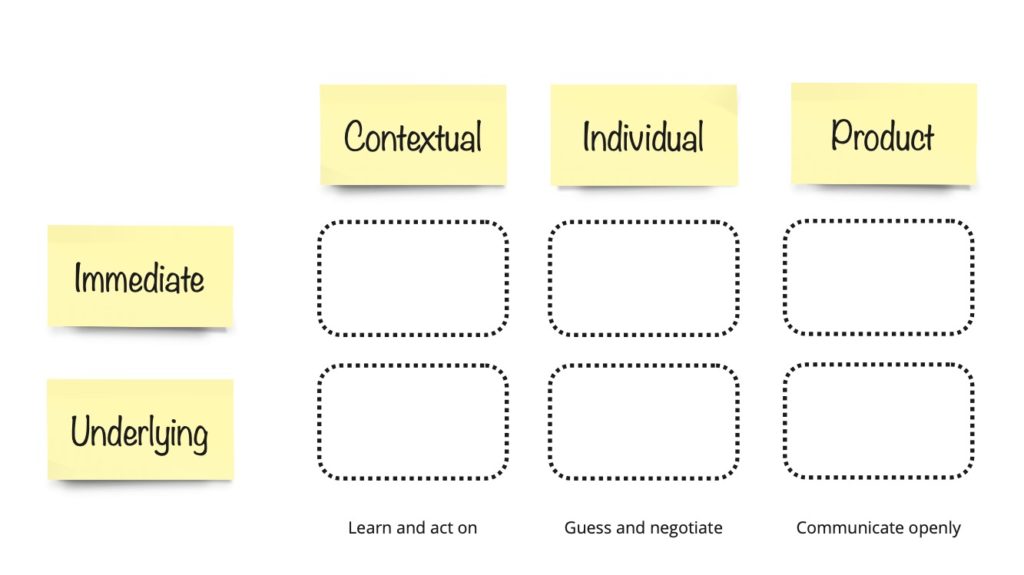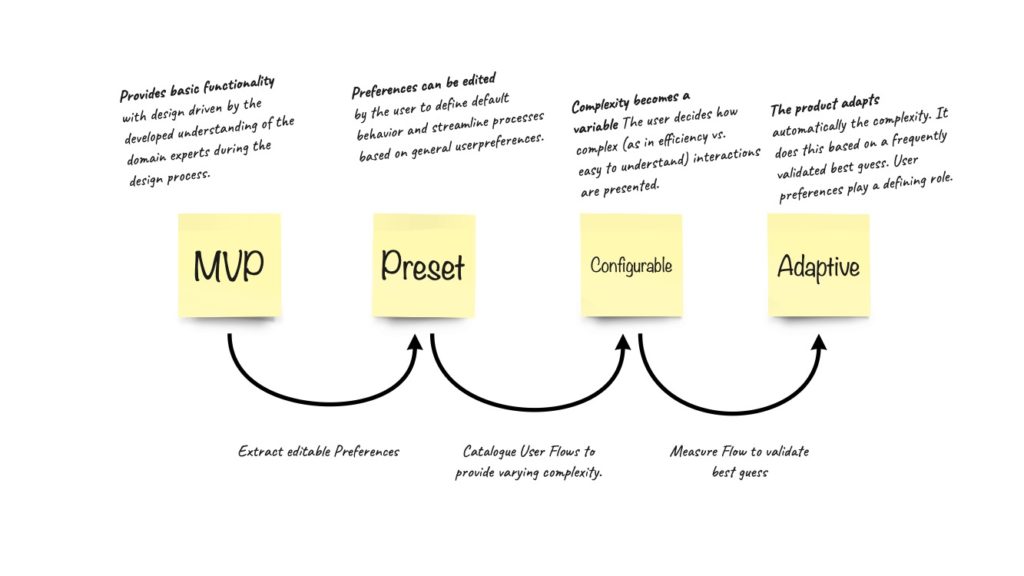Human Aware Design
Table of contents
- Motivation
- What we are missing
- What we are aiming for
- At the Core Human Aware means Contextual, Meaningful, Adaptive
- Conclusion
Motivation
If you are a fan of Design Thinking, Product Thinking or product design in general, you are in good company here. In this post, I will share my approach to product development. I like to think it goes further than the “user centric design“ approach you probably already know.
“User centric” is often used synonymously with human centric. This is not correct. We distinguish user centric as being focused on the practical needs of a user, where human centric includes on all human needs of the individual interacting with the software. We see humans being influenced by various factors, that are often not considered in product design, when we say “well, we start from the user needs”.
Humans are driven by emotions, held back by prejudices, establish mental models and views and build opinions. To date we are not taking these aspects of our users into account. We are not measuring them, not anticipating them nor are we reacting to or predicting them.
The good news: We are at a turning point. The existing understanding of computers, which was formed in the ’70s, namely a box in which we enter data and get a result, is dead. The new understanding is one of a readily available companion, an omniscient friend, who can support the user in all situations by connecting them to the rest of the world. A companion, who is able to sense what is good for the user and what is not. Who reacts to the immediate and underlying needs of the user, rather than a set of predetermined needs, that have been decided on in a design process earlier.
“What we see is not a direct reflection of the world, but a mental representation of the world, that is infused by our emotional experiences.” - Science Daily
What we are missing
The promise of user centric design is, if we were to follow these patterns correctly, we must end up with engaging experiences, that are satisfying to use, fulfil a business purpose and drive change. Yet, we often see the opposite. Solutions rarely gain the traction, they aim for, entice users and almost never evolve into something better from a poor start. Sure you are hearing the success stories of how a designer turned a product around or how a new technology positively changed an experience. Compared to the mass of products, however, these are rare individual cases. What is it then, that we are missing?
We are not understanding human emotion, feelings and behavior nor are we measuring their changes. We base our decisions on user segments and behaviour. Individual behaviour is (almost) completely invisible to us and it is generally (and for good reason) discouraged to base decisions on individual experiences.
Instead of sticking to a predefined pattern, that is rarely (and if then only by authority) updated, a more individual approach on tooling (the “how”) is required as well.
What we are aiming for
We need an approach, that is adaptable to a broad range of projects and challenges. An approach with an easy-to-understand concept and a comprehensive, flexible, non-dogmatic toolset. The approach should incorporate human-aspects from the ground up. It should also fit best-practices known today and incorporate current technological developments.
When designing products, we will consider the individual user and their context in every moment. We are not capable of knowing everything in advance – and the user is neither for that matter. We will therefore need to predict and adapt at runtime.
This approach on Human Aware Design will provide various tools, that can be used individually. It will also provide tools to map highly complex systems/environments, understand the dynamics within and model rules to mitigate undesirable aspects of these dynamics.
At the Core Human Aware means Contextual, Meaningful, Adaptive
Think about the characteristics of Human to Human interaction. You will recognise, that it is contextual aware, a meaningful interaction and adaptive in its complexity.
I Contextual awareness is if your partner knows when to stop talking because of something more important or when to repeat something because outside noise was preventing you from understanding.
II Meaningful Interaction is when your communication or interaction is not just purposeful, but the purpose is fully understood by all parties involved and they understand how the current interaction is contributing to the fulfilment of this purpose. Being asked for your gender during a hiring process is not meaningful, as there are generally questions on what is the purpose of this question and how it contributes to the overall success of the hiring process.
III Adaptive Complexity is generally applied by humans, when they rephrase something to avoid jargon. Another example would be to explain something in more or less detail based on the existing understanding of a listener. Good scholars and narraters are doing this intuitively. Knowing when the audience gets interested or bored.
Contextual Awareness is data driven

Based on Data, we can construct an artificial understanding of the environment. What is going right now? Are we in a hurry? Is what the user is doing currently critical for their success? Or simply: Are we on the move? Are we sleeping? There is few products out there, which are acting on information like this. Apple Watch (e.g. Alarm function, automatic training detection) and iOS Focus Modes are a good example of how to do this fairly good with current technology. It is automatically determining how to act based on its environment.
Evolving the WHEN, WHAT and the HOW for more Meaningful Interaction
WHEN interaction is taking place must not always be plannable, but it must be controllable by the user. Handing over control to the user results in empowerment and deeper engagement. When interaction is taking place it is more likely for the user to be readily available. If the control is granular, users will also see very clearly what kind of interaction the system aspires to and will gain a deeper understanding of its purpose and means of action.
WHAT In Order to make sure interaction is meaningful, we need transparency on the purpose to form an understanding of the value and the risk involved. With other humans this is negotiated. We are discussing, if something is important or not. It is the WHAT that needs to be cleared. What are we interacting upon? Is this necessary? How does this help me (the user)?
HOW Instead of using a form of communication (or channel) predetermined, we should aim to be capable of communication through as many channels as possible. And then let the user choose which channel to engage with (or be brave enough to choose one to start with and let the user change it later). They may even decide to switch channels mid conversation, which we should account for.

When thinking about interaction it quickly comes down to Distraction vs. Inspiration. Personal preference of the receiver of the communication has to play a more important role in this process. Where currently we are mostly ignorant of these preferences, we need to explore ways to learn about these preferences, catalogue them and adapt if they are changing in real time.
Empathy and Needs
In the Design Thinking process the first stage involves developing a sense of empathy towards the people you are designing for, to gain insights into what they need, what they want, how they behave, feel, and think, and why they demonstrate such behaviors, feelings, and thoughts when interacting with products in a real-world setting.
When empathising, we are often focussed on immediate user needs. We are not accounting for longterm, permanent effects and underlying needs, we are also not accounting for contextual/environmental needs. Nor do we take into account(especially on subsequent iterations) the needs, that the product puts into the mix.
We need to ask the right questions. On empathy and desire we are asking:
- How much time do we spend on empathising? When are we planning to do it?
- What does desirability mean in the context of the user?
- Why do the users have the needs we identified? What is driving those needs?
- Which other needs are correlating with these needs
- Which need(s) will this solution address?
- How will it fit into people’s lives?
- How will it appeal to them?
- Will people actually want it in their lives longterm?
On contextual and product needs we ask:
- What does the user try to accomplish in this context?
- Which other stakeholders are relevant in this context?
- What are the needs of these stakeholders?
- What expectations do we have towards the context in which the user is interacting with the product?
- What if these expectations are false?
- How does the context bind the attention of the user?
- What does the product need the user to do?
- When does the product need input by the user?
- What does successful interaction with the product result in for the user?

In reality, needs are competing as they are directly bound to our attention. Understand, that the needs your product has (e.g.immediate: I need the user to be notified of this transaction; underlying: I want to convey to the user, that there are options to influence the transaction) are positioned in that field.
Only if you understand the underlying and immediate needs of your product namely the things it needs the user to interact with to convey its purpose, you can think about how to communicate them effectively.
Aim at Adaptive Complexity
Adaptive Complexity is the ability to account for varying levels of engagement with whatever interaction you are in the process of having and to ensure a positive outcome in any case. More concretely this means, if the user is not willing or able to give the information, you need to proceed – why not guess it? If they already know how the product is to be used – why show them the tutorial?
Adaptability then is not a binary decision. It is a real effort and cost factor in creating good products. Luckily, there are steps towards Adaptability, that are already helping us design better products.

Conclusion
As a next step we need to evolve our ways of building products to be even more human centric, or human aware, as I’d like to call it. We need to reshape human machine interaction to become more inspirational and less distracting. It needs to become more like human to human interaction.
I laid out some of the tools and thinking behind my approach in this post and I hope you find this useful. If you have any thoughts on how to evolve the method, if you have used it or parts of its thinking knowingly or unknowingly, please get in touch and let’s talk!